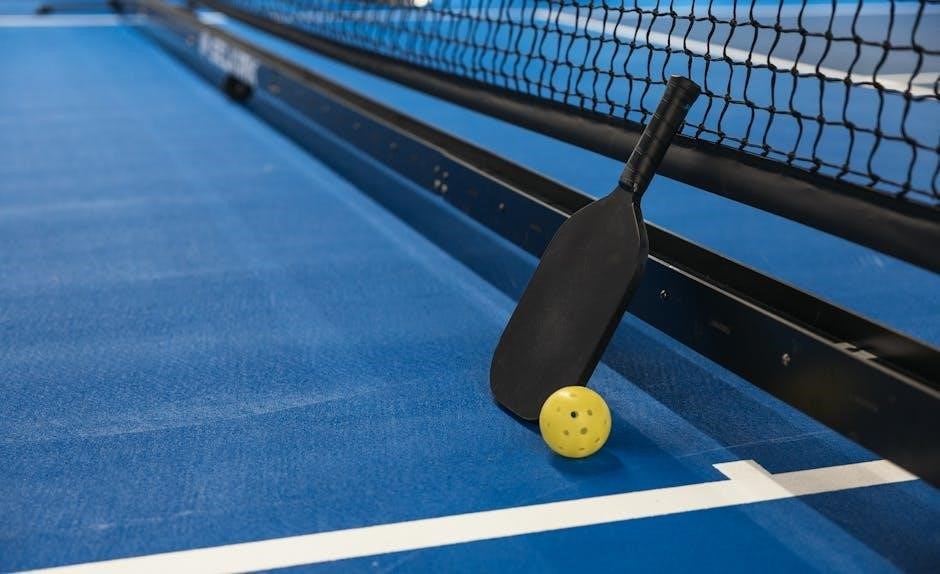pickleball drills pdf
Pickleball drills are essential for improving your game, offering structured exercises to enhance skills like serving, dinking, and volleying. A Pickleball drills PDF provides a comprehensive guide, helping players of all levels master techniques and strategies systematically.
1.1 Importance of Drills in Pickleball Training
Pickleball drills are fundamental for skill development and consistent improvement. They provide structured exercises to enhance specific techniques, such as serving, dinking, and volleying. Drills help players build a strong foundation, improve accuracy, and develop muscle memory. Regular practice through drills ensures better performance under game pressure. Additionally, drills promote repetition and focus, allowing players to refine their strokes and strategies. Whether for beginners or advanced players, drills are essential for mastering the game. A Pickleball drills PDF offers a comprehensive and organized approach to training, making it easier to follow and track progress effectively.
1.2 Benefits of Using a Pickleball Drills PDF
A Pickleball drills PDF offers numerous advantages for players seeking to enhance their skills. It provides a structured and organized approach to training, allowing players to focus on specific techniques such as dinking, serving, and groundstrokes. The PDF format ensures accessibility and portability, enabling players to review drills anytime, anywhere. Detailed descriptions, diagrams, and step-by-step instructions make learning easier. Additionally, a PDF guide helps track progress, set goals, and stay motivated. It serves as a valuable resource for both individual practice and team training, ensuring consistent improvement in gameplay. This tool is indispensable for players aiming to elevate their pickleball performance.
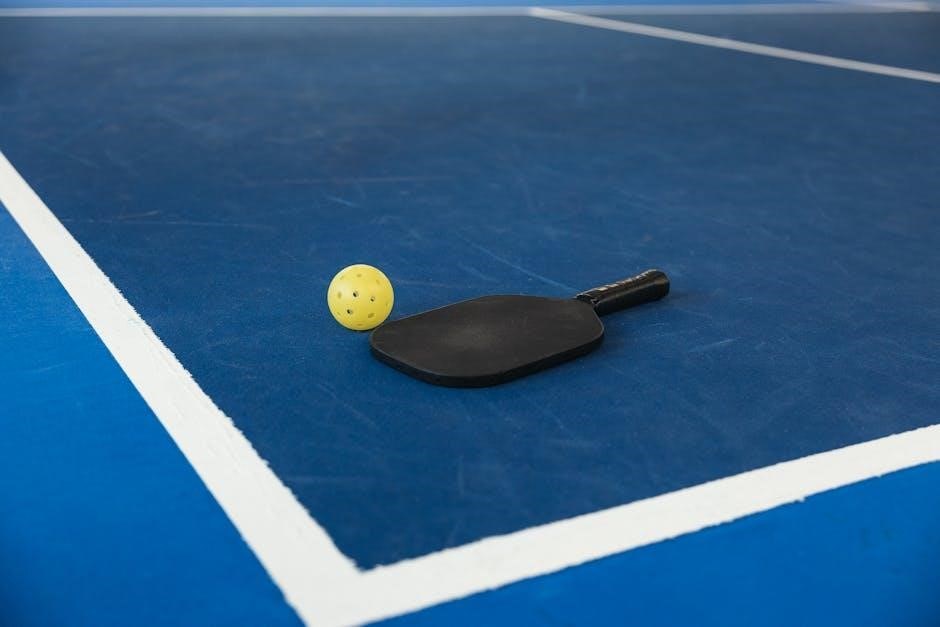
Warm-Up Drills
Warm-up drills are crucial to prepare players for pickleball, enhancing flexibility and coordination. Drills like the 5-Minute Dink Warm-Up focus on soft shots, while the Sidestep and Roll Drill improves footwork and balance. The Toss-to-Targets Warm-Up refines accuracy and control, ensuring players are ready for gameplay. These exercises help prevent injuries and sharpen reflexes, making them essential for a successful practice or match. By incorporating these drills, players can gradually increase intensity and transition smoothly into more demanding training sessions. A proper warm-up sets the foundation for effective skill development and overall performance improvement in pickleball.
2.1 5-Minute Dink Warm-Up
The 5-Minute Dink Warm-Up is a fundamental exercise to prepare players for pickleball. It involves hitting soft, controlled shots (dinks) across the net, focusing on precision and consistency. Players start on the same side, gradually incorporating cross-court shots to simulate game scenarios. This drill enhances hand-eye coordination, paddle control, and footwork. By maintaining a steady rhythm, players warm up their muscles and sharpen their reflexes. The goal is to keep the ball in play while transitioning smoothly into more dynamic movements. This warm-up is ideal for beginners and experienced players alike, ensuring a smooth transition into more intense training or gameplay.
2.2 Sidestep and Roll Drill
The Sidestep and Roll Drill focuses on improving agility and ball control. Partners stand 3-5 feet apart, sidestepping laterally while rolling a ball to each other. This exercise enhances footwork, balance, and coordination. Players must maintain low, ready positions and use soft hands to roll the ball accurately. The drill progresses by increasing the distance between partners, challenging their ability to control the ball while moving. It’s an excellent warm-up for developing the lateral movement and dexterity needed for pickleball, preparing players for game situations where quick, precise actions are essential.
2.3 Toss-to-Targets Warm-Up
The Toss-to-Targets Warm-Up is a fun and effective way to improve accuracy and control. Players stand several feet apart, with two targets per pair. They take turns underhand tossing a ball into the targets, focusing on precision and soft hands; This drill enhances dexterity, hand-eye coordination, and control, essential for pickleball. Gradually increasing the distance or adding smaller targets challenges players further. It’s an engaging warm-up that prepares players for game scenarios requiring accurate placement, such as third-shot drops or dinks. The goal is to build confidence and consistency in delivering the ball to specific spots on the court.
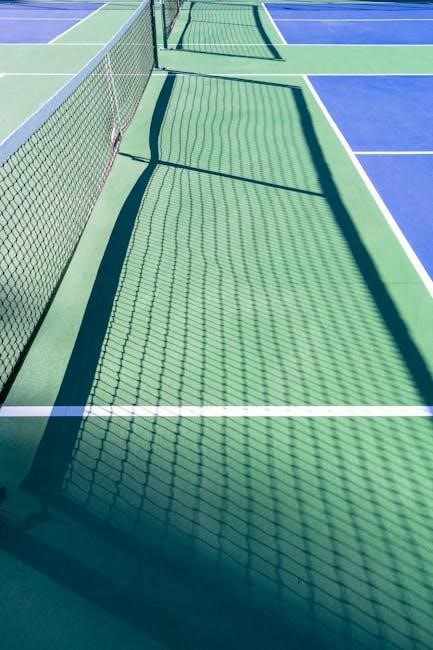
Basic Pickleball Skills Drills
Mastering fundamental skills like serving, returning, and third-shot drops is crucial for success. These drills focus on building consistency, accuracy, and strategic placement, forming the foundation of a strong game. A Pickleball drills PDF provides detailed exercises to refine these essential techniques, ensuring players develop a solid skill set for competitive play.
3.1 Serving Drills
Serving is the first opportunity to control the game, and effective drills ensure consistency and power. A Pickleball drills PDF offers structured exercises to master various serves, such as the basic underhand, spin, and deep serves. Players practice targeting specific zones on the court, improving accuracy and versatility. Drills like the “3-serve rotation” and “accuracy challenge” help build confidence and adaptability. These exercises are designed to simulate game scenarios, allowing players to refine their technique and develop a strategic serving style that keeps opponents guessing and enhances overall performance.
3.2 Return of Serve Drills
Return of serve drills focus on consistency and positioning, enabling players to effectively transition from defense to offense. A Pickleball drills PDF outlines exercises such as the “Deep Return Challenge” and “Third-Shot Drop Practice,” which emphasize proper footwork, paddle positioning, and shot placement. Players practice returning serves deep, soft, or angled, simulating game scenarios. These drills improve reaction time, accuracy, and the ability to read opponents’ serves. By mastering the return of serve, players can control the rally’s pace and gain a strategic advantage, making it a cornerstone of competitive play.
3.3 Third Shot Drop Drills
Third shot drop drills are designed to master the soft, precise shot that lands in the opponent’s kitchen, minimizing their offensive opportunities. A Pickleball drills PDF often includes exercises like the “3-D Drill” (Deep-Deep-Dink), where players practice deep serves, deep returns, and a third-shot dink. These drills focus on control, soft hands, and placement, ensuring the ball lands softly and strategically. Players learn to approach the non-volley zone (NVZ) line and execute drops with consistency. Mastery of the third shot drop enhances offensive transitions and forces opponents into defensive positions, making it a critical skill for competitive play.
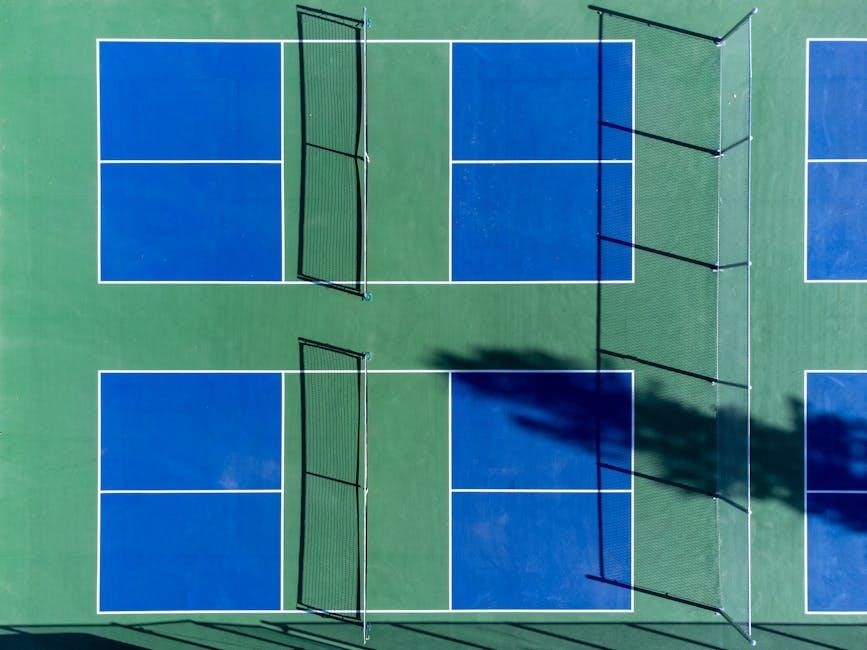
Groundstroke Drills
Groundstroke drills focus on mastering forehand and backhand shots, emphasizing consistency and accuracy. These exercises help players handle shots effectively and maintain rally continuity during gameplay.
4.1 Forehand Groundstroke Drill
The forehand groundstroke drill is designed to improve consistency and power in your forehand shots. Players line up behind the baseline, and balls are fed to their forehand side. Focus on proper footwork, racket positioning, and follow-through. Aim for deep, controlled shots to the opponent’s backhand. This drill helps build muscle memory and enhances your ability to handle groundstrokes effectively during rallies. Emphasize keeping the paddle angled slightly upward and using your body weight to generate power. Practice this drill regularly to develop a strong and reliable forehand, a cornerstone of any successful pickleball game.
4.2 Backhand Groundstroke Drill
The backhand groundstroke drill focuses on developing a strong and accurate backhand, essential for balanced gameplay. Players stand behind the baseline, and balls are hit to their backhand side. Emphasize proper footwork, with the backhand foot forward, and maintain a consistent paddle angle. Focus on controlled returns, aiming for depth and precision. Practice using both forehand and backhand swings to simulate game situations. This drill helps improve reaction time and stroke consistency, allowing players to confidently handle backhand shots during competitive play. Regular practice strengthens the backhand, complementing the forehand and enhancing overall groundstroke performance;
4.3 Cross-Court Groundstroke Drill
The cross-court groundstroke drill enhances accuracy and consistency by focusing on hitting shots diagonally across the court. Players line up on the baseline and take turns hitting forehand and backhand groundstrokes to the opposite side. Emphasize proper footwork and paddle positioning to generate power and control. Aim for deep, angled shots that land in the opponent’s backhand corner. This drill improves shot placement, footwork, and stamina while simulating game scenarios. By mastering cross-court groundstrokes, players can dominate rallies and create strategic advantages during matches, making this drill a key component of any comprehensive pickleball training regimen.
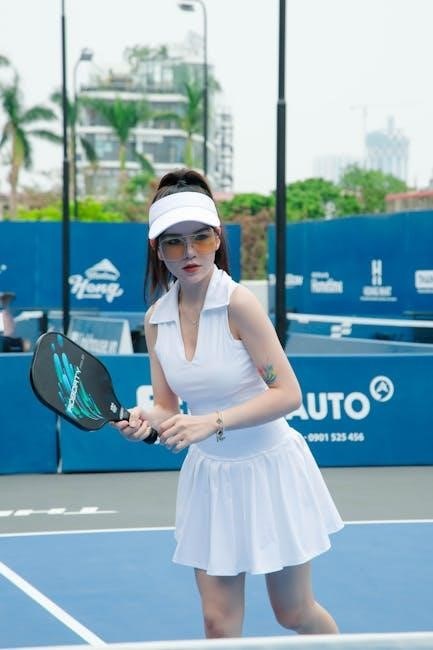
Volley Drills
Volley drills focus on improving hand-eye coordination, footwork, and paddle control. Players practice hitting volleys at the non-volley zone line, enhancing their ability to dominate at the net.
5.1 Volley Technique Drill
The Volley Technique Drill focuses on mastering the fundamentals of hitting precise volleys. Players pair up, with one feeding soft shots for the other to hit. Emphasizing proper paddle angle, foot positioning, and follow-through ensures consistency. Starting close to the net, gradually increase distance to simulate game scenarios. This drill improves reaction time and control, helping players develop a strong net game. By practicing volleys from both forehand and backhand sides, players build confidence and accuracy, making them more effective at the non-volley zone line.
5.2 Volley Footwork Drill
The Volley Footwork Drill enhances agility and positioning for effective volleys. Players pair up, with one feeding shots while the other practices moving into position. Focus on lateral shuffling, ensuring proper paddle and body alignment. Emphasize quick reactions and balanced footwork to cover the court efficiently. This drill improves responsiveness and positioning, crucial for making sharp volleys during gameplay. By simulating real-game scenarios, players develop the agility needed to excel at the net, ensuring they can swiftly move to hit precise volleys and maintain control over the rally.
5.3 Volley Placement Drill
The Volley Placement Drill focuses on precision and accuracy when hitting volleys. Players practice hitting shots to specific targets on the court, such as the opponent’s backhand or forehand. This drill helps develop control and strategic placement, ensuring volleys land where intended. By aiming for different zones, players improve their ability to direct the ball effectively, enhancing their overall offensive and defensive capabilities. Consistent practice of this drill builds confidence in hitting precise volleys, making players more formidable opponents during matches. It also reinforces the importance of communication and positioning with partners to maximize scoring opportunities.

Lob and Overhead Drills
Lob and Overhead Drills focus on mastering high-arcing shots and powerful smashes. Players practice timing and precision to execute effective lobs and overheads, enhancing their offensive and defensive game.
6.1 High-Arc Lob Drill
The High-Arc Lob Drill focuses on executing precise, high-arcing lobs to outmaneuver opponents. Players line up on both sides of the net, practicing lobbing the ball deeply into the opponent’s court. Emphasize proper paddle angle, wrist action, and follow-through for consistent control. Partners alternate hitting high-arcing shots, aiming for target zones to improve accuracy. This drill enhances lob placement and timing, while also fostering communication and positioning. Vary the drill by incorporating backhand and forehand lobs to develop a well-rounded skill set. Regular practice builds confidence in using the lob as a strategic weapon during gameplay.
6.2 Overhead Smash Drill
The Overhead Smash Drill is designed to master the powerful overhead shot, essential for finishing points. Players line up behind the baseline, practicing overhead smashes against high-arcing lobs or deep serves. Focus on proper positioning under the ball, paddle angle, and explosive power. Partners or coaches feed high balls, and players aim to smash into target zones. Emphasize footwork, timing, and wrist snap for consistency. Vary the drill by incorporating backhand and forehand smashes to simulate game scenarios. Regular practice enhances power, accuracy, and confidence in executing overhead smashes, making it a key weapon in competitive play.
6.3 Lob and Smash Combination Drill
The Lob and Smash Combination Drill trains players to seamlessly transition between offensive and defensive plays. Start with a high-arcing lob, followed by a powerful smash. Players practice hitting lobs deep into the opponent’s court, then quickly moving forward to smash returns. Emphasize timing, footwork, and paddle positioning for both shots. Incorporate variations, such as cross-court and down-the-line lobs, to simulate game situations. This drill improves reaction time, coordination, and court strategy, helping players dominate at the net and control the flow of the game effectively.
Dinking Drills
Dinking drills focus on soft, controlled shots to keep the ball low and in play. Essential for controlling game tempo, these exercises improve accuracy, patience, and strategic positioning on the court. Detailed in the Pickleball drills PDF, they provide structured routines to master this fundamental skill.
7.1 Dink Game – No Lob
The “Dink Game – No Lob” drill focuses on maintaining controlled, soft shots, emphasizing precision and consistency. Players hit the ball softly to keep it low, avoiding lobs. This exercise enhances accuracy, patience, and teamwork. Detailed in the Pickleball drills PDF, it provides structured routines to master this skill, improving game tempo and strategic positioning on the court. Regular practice helps players develop the finesse needed for competitive play, ensuring they can effectively control the ball during crucial moments. This drill is ideal for all skill levels, fostering improvement in a dynamic and engaging way.
7.2 Traveling Dinks Drill
The Traveling Dinks Drill involves partners starting on one side of the court, hitting soft, controlled shots to lead each other across the court. This exercise emphasizes precise ball placement and consistent control, helping players improve their dinking accuracy; Detailed in the Pickleball drills PDF, it outlines how to execute the drill effectively, focusing on maintaining a steady rhythm and clear communication between partners. The drill enhances teamwork and strategic positioning, making it an excellent way to refine dinking skills in a dynamic and engaging manner. Regular practice improves court awareness and shot consistency, essential for competitive play.
7.3 Dink Accuracy Drill
The Dink Accuracy Drill focuses on improving precision and consistency in dinking shots. Players aim to hit soft, controlled shots into specific target zones on the opponent’s side of the court. As detailed in the Pickleball drills PDF, this exercise involves setting up targets or using cones to define areas for accurate placement. Players take turns hitting dinks, scoring points for shots that land within the designated zones. This drill enhances focus, hand-eye coordination, and strategic shot placement, helping players develop the ability to place the ball where their opponent cannot easily return it, a crucial skill for advancing in the game.

Drop Shot Drills
The Drop Shot Drills focus on mastering the soft, precise shots that fall just over the net. These exercises, detailed in the Pickleball drills PDF, improve control, timing, and placement, helping players develop a strategic weapon to outplay opponents effectively.
8.1 Drop Shot Technique Drill
The Drop Shot Technique Drill emphasizes proper form and execution. Players practice hitting soft shots with minimal power, focusing on wrist control and angle of contact. Start with forehand and backhand strokes, aiming for the opponent’s backcourt. Gradually increase difficulty by varying shot depths and angles; This drill, detailed in the Pickleball drills PDF, helps build consistency and precision, making the drop shot a reliable tool in your game.
8.2 Drop Shot Control Drill
The Drop Shot Control Drill focuses on precision and consistency. Players line up at the non-volley zone line and hit drop shots into marked target areas on the opponent’s side. Start with short, soft shots and gradually increase distance. Emphasize using the wrist to control angle and depth. Partners or coaches provide feedback on placement and technique. This drill, outlined in the Pickleball drills PDF, helps refine touch and accuracy, making drop shots more effective in game situations. Repeat for both forehand and backhand to build overall control and confidence in executing this strategic shot.
8.3 Drop Shot Placement Drill
The Drop Shot Placement Drill enhances accuracy by targeting specific court areas. Set up cones or markers to define zones on the opponent’s side. Players take turns hitting drop shots, aiming for these zones. Focus on soft, angled hits to ensure the ball lands precisely within the targets. Partners or coaches provide feedback on placement and technique. This drill, detailed in the Pickleball drills PDF, helps players develop strategic shot placement, making their drop shots more effective in game scenarios. Alternate between forehand and backhand to build overall consistency and precision, ensuring better control over where the ball lands.
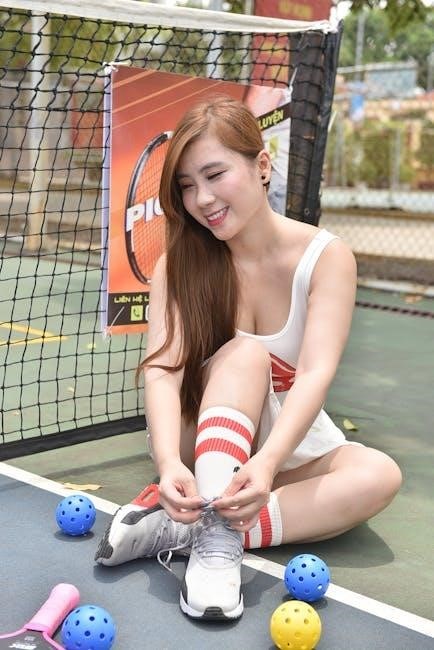
Scrimmage and Gameplay Drills
Scrimmage and gameplay drills simulate real-match scenarios, improving adaptability and teamwork. Players practice decision-making, positioning, and shot placement, enhancing their ability to apply techniques in competitive situations effectively.
9.1 Half-Court Scrimmage
The half-court scrimmage is a dynamic drill that focuses on strategic play within a smaller area. It emphasizes precise shot placement and effective communication between partners. By limiting the court size, players are forced to concentrate on controlled shots and quick movements, enhancing their reaction time and teamwork. This drill is particularly useful for improving dinking and drop shots, as well as refining net play strategies. Players can practice various scenarios, such as third-shot drops and lobs, to develop a well-rounded game. The half-court scrimmage is an excellent way to simulate game-like conditions while refining specific skills in a focused environment.
9.2 Full-Court Scrimmage
The full-court scrimmage is an intensive drill that replicates real-game conditions, allowing players to apply their skills in a dynamic, fast-paced environment. It focuses on transitioning between offense and defense, shot placement, and strategic positioning. Players practice rally scenarios, lobs, and smashes while refining their footwork and reaction time. This drill emphasizes teamwork, communication, and adaptability, helping players develop a competitive edge. By simulating match-like situations, the full-court scrimmage builds endurance and sharpens decision-making under pressure. It is an excellent way to integrate all previously learned techniques into a cohesive, high-energy game scenario.
9.3 Situation-Specific Drills
Situation-specific drills target precise game scenarios, such as third-shot drops, defensive lobs, and high-pressure returns. These exercises simulate real-match conditions, helping players master responses to common challenges. By focusing on specific situations, players improve decision-making and execution. For example, practicing drop shots under pressure enhances soft-game skills, while defensive drills build confidence in handling strong attacks. These drills are customizable to address individual or team weaknesses, ensuring tailored improvement. They bridge the gap between practice and competition, making players more versatile and prepared for any in-game situation they may face.
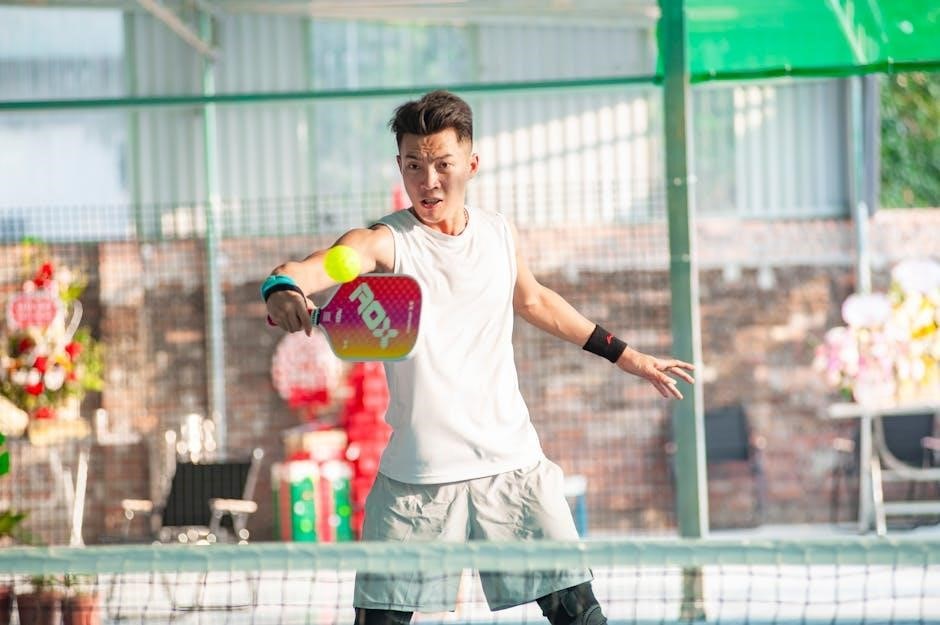
Mental and Physical Training Drills
Mental and physical drills combine exercises that enhance focus, reaction time, and stamina. These routines improve agility, strength, and endurance while building mental toughness and strategic thinking for peak performance.
10.1 Agility and Movement Drills
Agility and movement drills are designed to boost speed, balance, and quick directional changes on the pickleball court. These exercises often involve cone setups, ladder drills, and rapid side-to-side movements. Players weave through cones, perform shuffle runs, and practice explosive starts and stops. Incorporating paddle and ball control adds realism, simulating game scenarios. Drills like the “zig-zag” run and “box drill” enhance lateral movement, while “carioca” exercises improve agility and coordination. These drills not only improve physical performance but also prepare players for the fast-paced nature of pickleball, ensuring they can move efficiently and effectively during matches.
10.2 Reaction Time Drills
Reaction time drills are crucial for enhancing quick responses to shots in pickleball. These exercises focus on improving players’ ability to react swiftly to volleys, groundstrokes, and lobs. Multi-ball drills, where players face rapid sequences of shots, are highly effective. Surprise shots from partners or coaches also simulate game scenarios, forcing quick decisions. Players benefit by developing faster reflexes and sharper instincts, enabling them to anticipate opponents’ moves. Regular practice of these drills builds confidence and improves performance under pressure, making reaction time a key asset in competitive play.
10.3 Endurance and Stamina Drills
Endurance and stamina drills are designed to boost players’ physical fitness for prolonged matches. These exercises involve prolonged rallies, shuttle runs, and high-intensity interval training. Players engage in extended periods of continuous play, focusing on maintaining energy levels. Drills like “Rally Until Error” and “Court-to-Court Sprints” are effective. Incorporating strength training and plyometrics enhances muscle endurance. Hydration and recovery techniques are also emphasized. These drills ensure players can sustain their performance throughout the game, making them more competitive and resilient. Regular practice improves cardiovascular health and overall stamina, crucial for consistent play in pickleball.
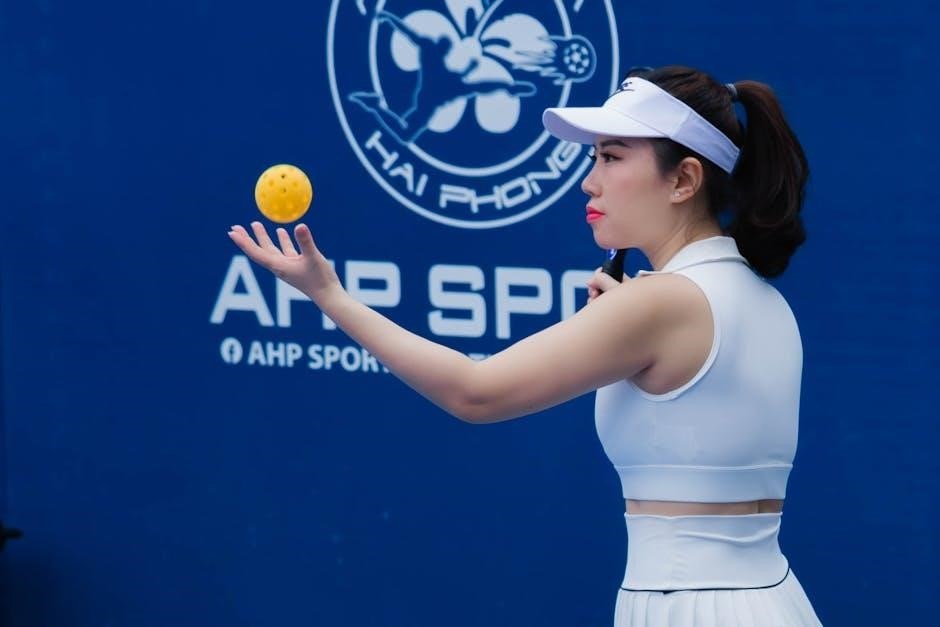
Cool-Down and Stretching Drills
Cool-down and stretching drills are essential after play to prevent injury and promote recovery. Gentle exercises like leg swings, arm circles, and hamstring stretches are included. Breathing techniques and foam rolling are also recommended to relax muscles and improve flexibility. These drills ensure a smooth transition from intense activity to rest, aiding in overall physical recovery and readiness for future games. Regular practice enhances mobility and reduces muscle tension, keeping players in optimal condition for consistent performance in pickleball.
11.1 Post-Play Stretching Routine
A post-play stretching routine is crucial for pickleball players to enhance recovery and maintain flexibility. Focus on major muscle groups: hamstrings, quadriceps, shoulders, and calves. Begin with gentle static stretches, holding each for 20-30 seconds. Incorporate dynamic stretches like leg swings and arm circles to promote blood flow. Include hamstring stretches by touching your toes and quad stretches by pulling your heel toward your glutes. Don’t forget shoulder rolls and chest opens to relieve tension. End with calves stretches and deep breathing to relax. This routine improves flexibility, reduces muscle stiffness, and prepares your body for the next game. Consistency is key for long-term benefits.
11.2 Foam Rolling and Recovery
Foam rolling is a vital recovery tool for pickleball players, helping to alleviate muscle tension and improve circulation. Focus on rolling your hamstrings, quads, IT band, and shoulders post-play. Use slow, controlled movements, applying moderate pressure on tight areas. Spend 30 seconds to a minute on each muscle group. This practice reduces muscle soreness, enhances flexibility, and promotes faster recovery. Incorporate deep breathing to relax further. Foam rolling complements stretching and is a simple yet effective way to maintain muscle health and prepare for future games. Consistency in this routine can significantly improve overall performance and reduce injury risk.
11.3 Relaxation and Breathing Exercises
Relaxation and breathing exercises are crucial for mental and physical recovery after pickleball. Start with deep diaphragmatic breaths: inhale deeply through your nose, hold for 3 seconds, then exhale slowly through your mouth. This reduces stress and calms your mind. Progressive muscle relaxation can also be beneficial—tense and release each muscle group from head to toe. Visualization techniques, such as imagining a successful game, enhance mental clarity. Pair these exercises with gentle stretches to improve flexibility and balance. Regular practice fosters a calm and focused mindset, enabling better performance on and off the court. Consistency is key to long-term benefits.
